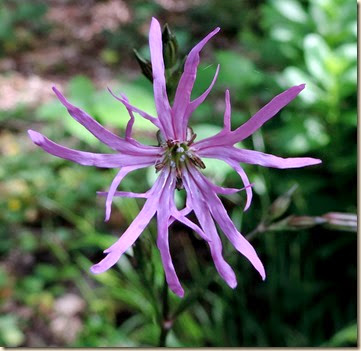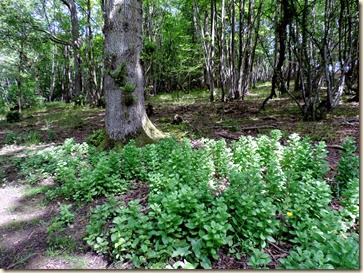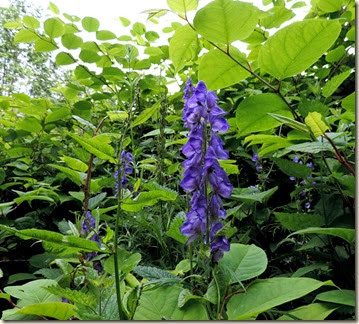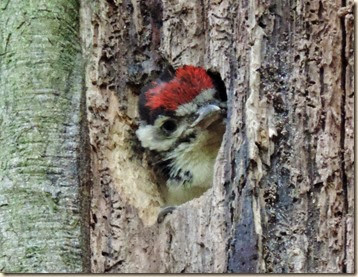I was looking around near Brede High Farm today when I discovered this stone of some unusual, hard, white material with a clear imprint of a fossilised leaf (top right).
On closer inspection the impression of the ancient Green Man appeared.
A weblog derived mainly from my own visits to the Woodland Trust property in East Sussex, UK. View details of events and current highlights. There is free access to all parts of the woods and the main car park is at map ref. TQ 804 206 off the B2089 (Cripps Corner to Rye road) almost opposite Watt's Palace Lane.
I was looking around near Brede High Farm today when I discovered this stone of some unusual, hard, white material with a clear imprint of a fossilised leaf (top right).
On closer inspection the impression of the ancient Green Man appeared.
This afternoon I spotted a solitary clouded yellow butterfly (Colias croceus) visiting the march thistle flowers in Holman Wood field.
There have been sightings of this immigrant species from several places in Sussex this year, so maybe we will get an invasion.
Some years ago we saw a female ovipositing on bird’s-foot trefoil in Pond Wood on the east of Brede High Woods. I took one egg home and kept it until it turned into a butterfly, then took it back to Pond Wood.
To our surprise there were maybe a dozen clouded yellows in the area. However, the species cannot survive the English winter, so these brief colonies will not be able to persist.
The second generation of common blue butterflies (Polyommatus icarus) is on the wing.
Although it was still warm and sunny at about 3.3pm, this female decided she would settle down on a rush stem. If you look at the tuft of brown flowers on the stalk, you will see a small, white, sausage-like protuberance on the left. This is the larval case of a Coleophorid micro-moth. They are usually very common on rush flower heads.
On the bank at the edge of the road where Frymans Lane meets Powdermill Lane (TQ80651934) there are a couple of quite distinctive spikes of the yellow flowers of fringed loosestrife (Lysimachia verticillaris) which grows as a native in north and east Turkey, Caucasia, Crimea and northern Iran. The identity has been confirmed by Hugh McAllister, an expert on this genus.
Quite where it has come from locally is difficult to suggest. It is certainly a garden escape, but this particular corner is not the best place for fly tipping garden waste. It apparently does not set viable seed in this country.
McAllister’s paper on this group of plants is here: http://archive.bsbi.org.uk/Wats22p279.pdf
The konik horses are making small areas of grazing among the scrub and many of these are now brightened with lesser spearwort (Ranunculus flammula). ‘Flammula’ is Latin for ‘little flame’, perhaps referring to the brightness of the flowers, or maybe the shape of the leaves.
There are many other yellow flowers along the sides of the rides in the woods at the moment.
Trailing St. John’s wort (Hypericum humifusum)
Common cat’s-ear (Hypochaeris radicata). Apparently the leaves of this are edible and not normally bitter like dandelions. They can be eaten raw in salads, or cooked.
Tormentil (Potentilla erecta) is typical of heathy spots. The roots are very bitter and produce a reddish dye, and are used to make a powerful alcoholic beverage in Germany called Blutwurz (blood root) – the same name as the plant.
Tormentil is one of several Potentilla species in the woods and the plant also hybridises a great deal and clones often difficult to distinguish one from another
The cutting back of the vegetation along the pylon line has reopened the view into the Tillingham Valley. So far as I know, this is the only view northwards from Brede High Woods. The transmission lines cross the road and run down through Whorne Wood. The furthest point is 1.5 km away at the top of the ridge about 170 metres south of the B2165 Staplecross to Beckley road. The river Tillingham is at the bottom of the first hill.
Enjoy the view from just west of the eastern car park at grid ref TQ80322066.
Today I parked the car at the eastern end of Brede High Woods and followed footpath from the corner of Powdermill and Reservoir Lane to the first pylon.
All the vegetation underneath the transmission wires has been cleared, as happens every few years, giving and opportunity for wildlife that likes open ground to spread and to reach new areas by following the transmission lines. It is, in effect, a linear meadow between woods ancient and modern.
At the start of the walk I spotted a hazel-leaf roller weevil, Apoderus coryli, on (surprise, surprise) a hazel leaf. These curious little insects cut slits in hazel leaves and roll them up into tubes for their larvae to live in.
The brambles are now in full bloom and, where they grow beside a sunny, open ride, they represent a magnificent resource for wildlife. They offer much nectar, pollen and, later on fruit for insects and other creatures; they are a foodplant for many more, they provide shelter, they are hosts to many small fungi, and their dead stems even offer handy tubes for small bees to nest.
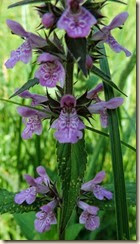 Around the first pylon there were many meadow brown and ringlet butterflies and the marsh woundwort still grows there.
Around the first pylon there were many meadow brown and ringlet butterflies and the marsh woundwort still grows there.
Best of all was the arrival of the first summer silver-washed fritillaries (Argynnis paphia).
This continues to spread through the wood and I think this is the furthest east I have seen it. The picture on the left shows the whitish flashes on the hind underwing because of which the name ‘silver-washed’ was coined.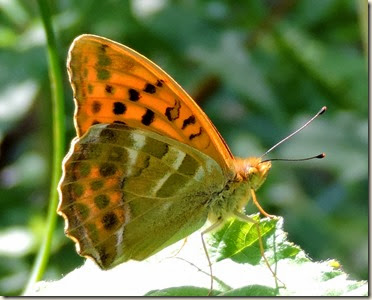
Later, close to Keeper’s Cottage about halfway across the wood, I found a bush of red currant (Ribes rubrum) bearing and appreciable amount of ripe fruit. This plant is not uncommon close to streams in our local woods, but the fruit hardly ever ripens before the birds get it. Also the leaves on this bush seem a bit different to the usual wild ones. Maybe it is a survivor from the Keeper’s Cottage garden.
